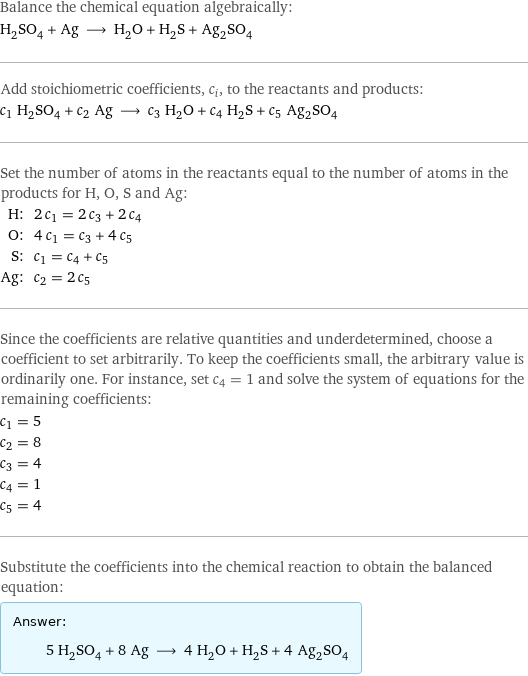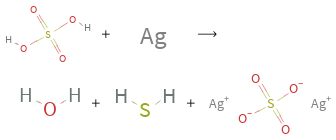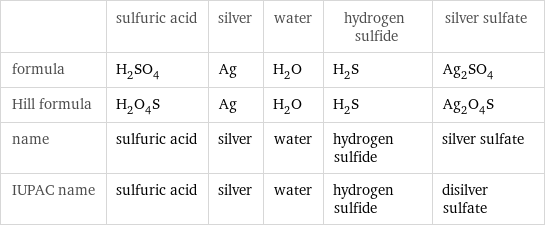Input interpretation

H_2SO_4 sulfuric acid + Ag silver ⟶ H_2O water + H_2S hydrogen sulfide + Ag_2SO_4 silver sulfate
Balanced equation

Balance the chemical equation algebraically: H_2SO_4 + Ag ⟶ H_2O + H_2S + Ag_2SO_4 Add stoichiometric coefficients, c_i, to the reactants and products: c_1 H_2SO_4 + c_2 Ag ⟶ c_3 H_2O + c_4 H_2S + c_5 Ag_2SO_4 Set the number of atoms in the reactants equal to the number of atoms in the products for H, O, S and Ag: H: | 2 c_1 = 2 c_3 + 2 c_4 O: | 4 c_1 = c_3 + 4 c_5 S: | c_1 = c_4 + c_5 Ag: | c_2 = 2 c_5 Since the coefficients are relative quantities and underdetermined, choose a coefficient to set arbitrarily. To keep the coefficients small, the arbitrary value is ordinarily one. For instance, set c_4 = 1 and solve the system of equations for the remaining coefficients: c_1 = 5 c_2 = 8 c_3 = 4 c_4 = 1 c_5 = 4 Substitute the coefficients into the chemical reaction to obtain the balanced equation: Answer: | | 5 H_2SO_4 + 8 Ag ⟶ 4 H_2O + H_2S + 4 Ag_2SO_4
Structures

+ ⟶ + +
Names

sulfuric acid + silver ⟶ water + hydrogen sulfide + silver sulfate
Reaction thermodynamics
Enthalpy

| sulfuric acid | silver | water | hydrogen sulfide | silver sulfate molecular enthalpy | -814 kJ/mol | 0 kJ/mol | -285.8 kJ/mol | -20.6 kJ/mol | -715.9 kJ/mol total enthalpy | -4070 kJ/mol | 0 kJ/mol | -1143 kJ/mol | -20.6 kJ/mol | -2864 kJ/mol | H_initial = -4070 kJ/mol | | H_final = -4028 kJ/mol | | ΔH_rxn^0 | -4028 kJ/mol - -4070 kJ/mol = 42.48 kJ/mol (endothermic) | | | |
Entropy

| sulfuric acid | silver | water | hydrogen sulfide | silver sulfate molecular entropy | 157 J/(mol K) | 42.6 J/(mol K) | 69.91 J/(mol K) | 206 J/(mol K) | 200.4 J/(mol K) total entropy | 785 J/(mol K) | 340.8 J/(mol K) | 279.6 J/(mol K) | 206 J/(mol K) | 801.6 J/(mol K) | S_initial = 1126 J/(mol K) | | S_final = 1287 J/(mol K) | | ΔS_rxn^0 | 1287 J/(mol K) - 1126 J/(mol K) = 161.4 J/(mol K) (endoentropic) | | | |
Equilibrium constant
![Construct the equilibrium constant, K, expression for: H_2SO_4 + Ag ⟶ H_2O + H_2S + Ag_2SO_4 Plan: • Balance the chemical equation. • Determine the stoichiometric numbers. • Assemble the activity expression for each chemical species. • Use the activity expressions to build the equilibrium constant expression. Write the balanced chemical equation: 5 H_2SO_4 + 8 Ag ⟶ 4 H_2O + H_2S + 4 Ag_2SO_4 Assign stoichiometric numbers, ν_i, using the stoichiometric coefficients, c_i, from the balanced chemical equation in the following manner: ν_i = -c_i for reactants and ν_i = c_i for products: chemical species | c_i | ν_i H_2SO_4 | 5 | -5 Ag | 8 | -8 H_2O | 4 | 4 H_2S | 1 | 1 Ag_2SO_4 | 4 | 4 Assemble the activity expressions accounting for the state of matter and ν_i: chemical species | c_i | ν_i | activity expression H_2SO_4 | 5 | -5 | ([H2SO4])^(-5) Ag | 8 | -8 | ([Ag])^(-8) H_2O | 4 | 4 | ([H2O])^4 H_2S | 1 | 1 | [H2S] Ag_2SO_4 | 4 | 4 | ([Ag2SO4])^4 The equilibrium constant symbol in the concentration basis is: K_c Mulitply the activity expressions to arrive at the K_c expression: Answer: | | K_c = ([H2SO4])^(-5) ([Ag])^(-8) ([H2O])^4 [H2S] ([Ag2SO4])^4 = (([H2O])^4 [H2S] ([Ag2SO4])^4)/(([H2SO4])^5 ([Ag])^8)](../image_source/6b6e8a699ac1f7088b14ff907ba1c66b.png)
Construct the equilibrium constant, K, expression for: H_2SO_4 + Ag ⟶ H_2O + H_2S + Ag_2SO_4 Plan: • Balance the chemical equation. • Determine the stoichiometric numbers. • Assemble the activity expression for each chemical species. • Use the activity expressions to build the equilibrium constant expression. Write the balanced chemical equation: 5 H_2SO_4 + 8 Ag ⟶ 4 H_2O + H_2S + 4 Ag_2SO_4 Assign stoichiometric numbers, ν_i, using the stoichiometric coefficients, c_i, from the balanced chemical equation in the following manner: ν_i = -c_i for reactants and ν_i = c_i for products: chemical species | c_i | ν_i H_2SO_4 | 5 | -5 Ag | 8 | -8 H_2O | 4 | 4 H_2S | 1 | 1 Ag_2SO_4 | 4 | 4 Assemble the activity expressions accounting for the state of matter and ν_i: chemical species | c_i | ν_i | activity expression H_2SO_4 | 5 | -5 | ([H2SO4])^(-5) Ag | 8 | -8 | ([Ag])^(-8) H_2O | 4 | 4 | ([H2O])^4 H_2S | 1 | 1 | [H2S] Ag_2SO_4 | 4 | 4 | ([Ag2SO4])^4 The equilibrium constant symbol in the concentration basis is: K_c Mulitply the activity expressions to arrive at the K_c expression: Answer: | | K_c = ([H2SO4])^(-5) ([Ag])^(-8) ([H2O])^4 [H2S] ([Ag2SO4])^4 = (([H2O])^4 [H2S] ([Ag2SO4])^4)/(([H2SO4])^5 ([Ag])^8)
Rate of reaction
![Construct the rate of reaction expression for: H_2SO_4 + Ag ⟶ H_2O + H_2S + Ag_2SO_4 Plan: • Balance the chemical equation. • Determine the stoichiometric numbers. • Assemble the rate term for each chemical species. • Write the rate of reaction expression. Write the balanced chemical equation: 5 H_2SO_4 + 8 Ag ⟶ 4 H_2O + H_2S + 4 Ag_2SO_4 Assign stoichiometric numbers, ν_i, using the stoichiometric coefficients, c_i, from the balanced chemical equation in the following manner: ν_i = -c_i for reactants and ν_i = c_i for products: chemical species | c_i | ν_i H_2SO_4 | 5 | -5 Ag | 8 | -8 H_2O | 4 | 4 H_2S | 1 | 1 Ag_2SO_4 | 4 | 4 The rate term for each chemical species, B_i, is 1/ν_i(Δ[B_i])/(Δt) where [B_i] is the amount concentration and t is time: chemical species | c_i | ν_i | rate term H_2SO_4 | 5 | -5 | -1/5 (Δ[H2SO4])/(Δt) Ag | 8 | -8 | -1/8 (Δ[Ag])/(Δt) H_2O | 4 | 4 | 1/4 (Δ[H2O])/(Δt) H_2S | 1 | 1 | (Δ[H2S])/(Δt) Ag_2SO_4 | 4 | 4 | 1/4 (Δ[Ag2SO4])/(Δt) (for infinitesimal rate of change, replace Δ with d) Set the rate terms equal to each other to arrive at the rate expression: Answer: | | rate = -1/5 (Δ[H2SO4])/(Δt) = -1/8 (Δ[Ag])/(Δt) = 1/4 (Δ[H2O])/(Δt) = (Δ[H2S])/(Δt) = 1/4 (Δ[Ag2SO4])/(Δt) (assuming constant volume and no accumulation of intermediates or side products)](../image_source/d3e7c98b1a20de26cef89e9a9bc8cebd.png)
Construct the rate of reaction expression for: H_2SO_4 + Ag ⟶ H_2O + H_2S + Ag_2SO_4 Plan: • Balance the chemical equation. • Determine the stoichiometric numbers. • Assemble the rate term for each chemical species. • Write the rate of reaction expression. Write the balanced chemical equation: 5 H_2SO_4 + 8 Ag ⟶ 4 H_2O + H_2S + 4 Ag_2SO_4 Assign stoichiometric numbers, ν_i, using the stoichiometric coefficients, c_i, from the balanced chemical equation in the following manner: ν_i = -c_i for reactants and ν_i = c_i for products: chemical species | c_i | ν_i H_2SO_4 | 5 | -5 Ag | 8 | -8 H_2O | 4 | 4 H_2S | 1 | 1 Ag_2SO_4 | 4 | 4 The rate term for each chemical species, B_i, is 1/ν_i(Δ[B_i])/(Δt) where [B_i] is the amount concentration and t is time: chemical species | c_i | ν_i | rate term H_2SO_4 | 5 | -5 | -1/5 (Δ[H2SO4])/(Δt) Ag | 8 | -8 | -1/8 (Δ[Ag])/(Δt) H_2O | 4 | 4 | 1/4 (Δ[H2O])/(Δt) H_2S | 1 | 1 | (Δ[H2S])/(Δt) Ag_2SO_4 | 4 | 4 | 1/4 (Δ[Ag2SO4])/(Δt) (for infinitesimal rate of change, replace Δ with d) Set the rate terms equal to each other to arrive at the rate expression: Answer: | | rate = -1/5 (Δ[H2SO4])/(Δt) = -1/8 (Δ[Ag])/(Δt) = 1/4 (Δ[H2O])/(Δt) = (Δ[H2S])/(Δt) = 1/4 (Δ[Ag2SO4])/(Δt) (assuming constant volume and no accumulation of intermediates or side products)
Chemical names and formulas

| sulfuric acid | silver | water | hydrogen sulfide | silver sulfate formula | H_2SO_4 | Ag | H_2O | H_2S | Ag_2SO_4 Hill formula | H_2O_4S | Ag | H_2O | H_2S | Ag_2O_4S name | sulfuric acid | silver | water | hydrogen sulfide | silver sulfate IUPAC name | sulfuric acid | silver | water | hydrogen sulfide | disilver sulfate